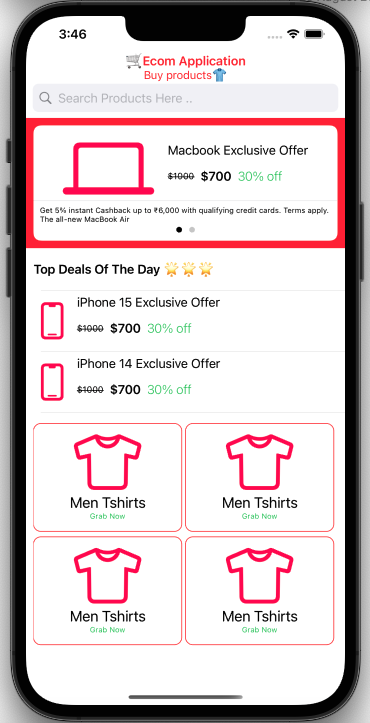
In this tutorial we will create a mini SwiftUI App with complex interference. We will cover following modules by creating mini E-commerce SwiftUI Application, Here all SFSymbol icons are used so It’s lightweight and no external image dependencies 🙂
- A NavigationBar in SwiftUI with custom title colour
- SearchBar in swiftUI
- Pager in SwiftUI with page-control buttons
- Fix height list in swiftUI
- Grid in SwiftUI with customisation
Let’s jump to the code –
1. Create SearchBar in SwiftUI –
- Use
TextFieldwith.overlay(of search icon - We have used
HStackhere because SearchTextField Cross icon and Cancel button all are aligned horizontally isEditingModeis used to know weather to searchBar is Active ? if so show up cancel button.- This is UI Only code as in this article we are focusing on building UI with many components.
A precise code would be –>
import SwiftUI
struct SearchBarView: View {
@State private var isEditingMode = false
@Binding var currentSearchText: String
var body: some View {
HStack {
TextField("Search Products Here ..", text: $currentSearchText)
.padding(8)
.padding(.horizontal, 26)
.background(Color(.systemGray6))
.cornerRadius(8)
.overlay(
HStack {
Image(systemName: "magnifyingglass")
.foregroundColor(.gray)
.frame(minWidth: 0, maxWidth: .infinity, alignment: .leading)
.padding(.leading, 7)
if isEditingMode {
Button(action: {
self.currentSearchText = ""
}) {
Image(systemName: "multiply.circle.fill")
.foregroundColor(.gray)
.padding(.trailing, 7)
}
}
}
)
.padding(.horizontal, 9)
.onTapGesture {
self.isEditingMode = true
}
if isEditingMode {
Button(action: {
self.isEditingMode = false
self.currentSearchText = ""
}) {
Text("Cancel")
}
.padding(.trailing, 9)
.animation(.easeOut)
}
}
}
}
struct SearchBarView_Previews: PreviewProvider {
static var previews: some View {
SearchBarView(currentSearchText: .constant(""))
}
}2. Creating Pager in SwiftUI
TabViewis used to create pager in SwiftUI clip shape for customisationclipShape(RoundedRectangle(cornerRadius: 10.0, style: .continuous))setupAppearanceForPager()is used for changing colour of the Pager dots which invokes on.onAppearmethod- Select
TabViewStyle.tabViewStyle(PageTabViewStyle())this settings is for pager
code for pager —>
import SwiftUI
struct PageView: View {
var body: some View {
TabView {
ForEach(0..<2) { i in
ZStack {
Color.white
VStack {
HStack() {
Image(systemName: "laptopcomputer")
.resizable()
.aspectRatio(contentMode: .fit)
.frame(height: 70)
.foregroundColor(.pink)
VStack(alignment: .leading, spacing: 0) {
// Spacer()
Text("Macbook Exclusive Offer")
.padding(.leading,10)
.foregroundColor(.black)
HStack{
Text("$1000")
.strikethrough(true, color: .black)
.padding(.leading,10).font(.caption)
Text ("$700")
.font(Font.headline.weight(.semibold))
Text ("30% off")
.font(Font.body.weight(.light))
.foregroundColor(.green)
}
.foregroundColor(.black)
//Spacer()
.frame(height: 50)
}
}
Divider()
Text("Get 5% instant Cashback up to ₹6,000 with qualifying credit cards. Terms apply. The all-new MacBook Air")
.font(.system(size: 10))
}
}
.clipShape(RoundedRectangle(cornerRadius: 10.0, style: .continuous))
}
.padding([.all], 10)
}
.frame(maxHeight: .infinity)
.frame(width: UIScreen.main.bounds.width)
.tabViewStyle(PageTabViewStyle())
.background(Color.red)
.onAppear {
setupAppearanceForPager()
}
}
func setupAppearanceForPager() {
UIPageControl.appearance().currentPageIndicatorTintColor = .black
UIPageControl.appearance().pageIndicatorTintColor = UIColor.black.withAlphaComponent(0.2)
}
}
struct PageView_Previews: PreviewProvider {
static var previews: some View {
PageView()
}
}3. Creating Custom List in SwiftUI
- Create
DeviceEntitymodel for dataSet of List or TableView - Since we have items in horizontally use List with
HStack .listStyle(.plain)used for remove padding from the List rows- To setup image in list with custom height
resizableused withaspectRatioto.fit strikethroughused to make a Old & New price label
Code for ListView –>
import SwiftUI
struct DeviceEntity:Identifiable {
let id = UUID()
var name: String
}
struct ProductListView: View {
@State var deviceList:[DeviceEntity] = [DeviceEntity(name: "iPhone 15 Exclusive Offer"),
DeviceEntity(name: "iPhone 14 Exclusive Offer")]
var body: some View {
List(deviceList) { currentObject in
HStack {
Image(systemName: "iphone")
.resizable()
.aspectRatio(contentMode: .fit)
.frame(height: 50, alignment: .center)
.foregroundColor(.pink)
VStack(alignment: .leading, spacing: 0) {
// Spacer()
Text(currentObject.name)
.padding(.leading,10)
HStack{
Text("$1000")
.strikethrough(true, color: .black)
.padding(.leading,10).font(.caption)
Text ("$700")
.font(Font.headline.weight(.semibold))
Text ("30% off")
.font(Font.body.weight(.light))
.foregroundColor(.green)
}
//Spacer()
.frame(height: 50)
}//.environment(\.defaultMinListRowHeight, 100)
}
}
.listStyle(.plain)
.frame(height:170)
}
}
struct ProductListView_Previews: PreviewProvider {
static var previews: some View {
ProductListView()
}
}4. Create Custom Grid in SwiftUI
- Here we are creating Grid or collectionview in swiftUI by using
LazyHGrid itemsRangeForGriddefines how many item required for the Grid, in our current example we are creating Grid of 4 itemsGridItemfor item configuration- As in our example we have set of two items vertically we will be using
VStack& add Images & Text there .overlay( is used to create BorderRadius with colour
import SwiftUI
struct CustomGridLayout: View {
let itemsRangeForGrid = 1...4
let gridRows = [
GridItem(spacing:5),
GridItem(spacing: 5),
]
let gridItemWidth = (UIScreen.main.bounds.width-30)/2
var body: some View {
ScrollView(.horizontal) {
LazyHGrid(rows: gridRows, alignment: .center,spacing: 5) {
ForEach(itemsRangeForGrid, id: \.self) { item in
ZStack {
VStack(alignment: .center, spacing: 5) {
Image(systemName: "tshirt")
.resizable()
.aspectRatio(contentMode: .fit)
.frame(height: 75, alignment: .center)
.foregroundColor(.pink)
Text("Men Tshirts")
.frame(maxWidth: .infinity, alignment: .center)
.font(.system(size: 20))
Text("Grab Now")
.frame(maxWidth: .infinity, alignment: .center)
.foregroundColor(.green)
.font(.system(size: 10))
}.frame(width: gridItemWidth, height:145, alignment: .center)
.overlay(
RoundedRectangle(cornerRadius: 10)
.stroke(Color.red, lineWidth: 1)
)
}
}
}
.frame(height: 300)
}
.padding([.leading, .trailing],10)
}
}
struct GridLayout_Previews: PreviewProvider {
static var previews: some View {
CustomGridLayout()
}
}5. Dashboard file where we link all SwiftUI View
NavigationViewis used for creating Navigation in SwiftUI & We will Embed all item to ScrollView so that user can scroll over items
Since we have long vertical list we are usingVStack- Use .
toolbarfor setting unavigationBartitle & Text .navigationBarTitleDisplayMode(.inline)For shorternavigationBar
import SwiftUI
struct ContentView: View {
@State var searchBarText:String = ""
var body: some View {
NavigationView {
ScrollView {
VStack(alignment: .leading) {
SearchBarView(currentSearchText: $searchBarText)
LazyHStack {
PageView()
}
.padding([.all], 0)
.background(Color.blue)
.frame(height:175)
Text("Top Deals Of The Day 🌟🌟🌟")
.multilineTextAlignment(.leading)
.padding(.all, 10)
.font(.headline)
ProductListView()
CustomGridLayout()
//Spacer()
}
.toolbar {
ToolbarItem(placement: .principal) {
VStack {
Text("🛒Ecom Application").font(.headline)
Text("Buy products👕").font(.subheadline)
}
.foregroundColor(.red)
}
}
}
.navigationBarTitleDisplayMode(.inline)
}
}
}
struct Dashboard_Previews: PreviewProvider {
static var previews: some View {
ContentView()
}
}That’s all 🙂
Complete Source code available here